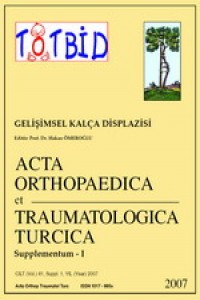Abstract
Kalça ultrasonografisi (USG), muayene yöntemlerinin değişmesine bağlı olarak Avrupa ve ABD’de farklı biçimde değerlendirilmektedir. Bu yüzden, sonuçlar da farklılık göstermektedir. Avusturya, İsviçre, Almanya ve diğer ülkelerde uygulanan yöntem, kesin kurallarla stardarda bağlanmış, yenilenebilir, deneyim ve yetenekten bağımsızlaştırılmış bir yöntemdir. Avusturya’da kalçaya açık redüksiyon uygulama oranı 0.13/1000 canlı doğuma düşürülmüştür. Bu oran Almanya’da 0.26/1000’dir. Bunlar, tüm dünyada bildirilen en düşük oranlardır. Sonografi öncesi döneme göre masraflar da üç kat azalmıştır. Bu gelişmelerin nedeni, eğitimin deneyimli kişiler tarafından verilmesi, USG incelemesinin doğumdan sonraki altı hafta içinde yapılması ve tedavinin sonografi tiplerine göre planlanmasıdır.
Keywords
Abstract
Approach to hip sonography in Europe differs considerably from that in the USA, with different examination techniques and, therefore, discrepant results. The method used in Austria, Switzerland, Germany, and other countries is strictly standardized, reproducable, and out of the experience and skill of the examiner. Open reductions have been reduced to 0.13/1000 newborn babies in Austria, and to 0.26/1000 in Germany. This is the lowest rate which ever has been reported in the world. Costs for screening and treatment are three times lower than in the presonography era. These improvements result from training given by authorized teachers, implementation of ultrasonography screening program within the first six weeks of life, and planning treatment according to the sonography types.
Keywords
Details
| Primary Language | English |
|---|---|
| Subjects | Health Care Administration |
| Journal Section | Review |
| Authors | |
| Publication Date | April 18, 2007 |
| Published in Issue | Year 2007 Volume: 41 |

